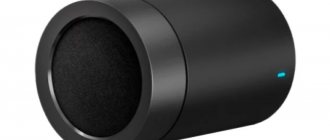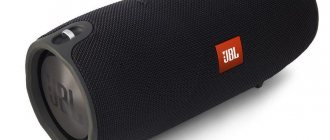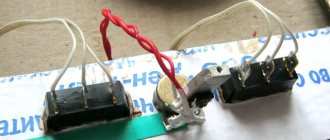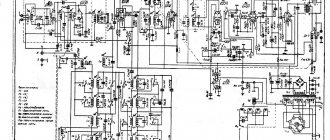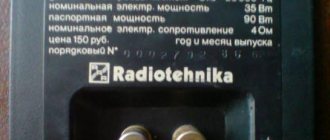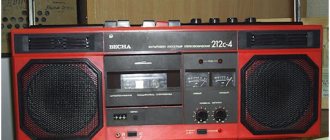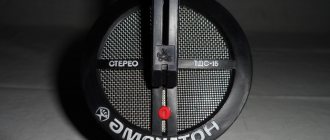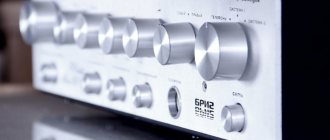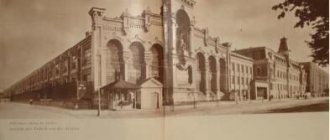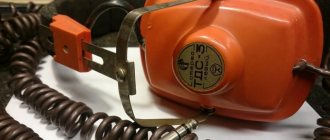Acoustic systems (AS), commonly referred to as speakers or simply acoustics, are the final link of almost any stereo system that reproduces sound by converting an electrical signal coming from a power amplifier, first into mechanical vibrations of a loudspeaker, and then into sound vibrations in the air. The first industrial prototypes of modern speakers (what could be called “loudspeaker boxes”) appeared on the world market in 1926. Nevertheless, even today, Soviet speakers are in steady demand not only among lovers of “vintage antiquities,” but also among connoisseurs of quality and reliability. For all interested categories of readers, this material will present the TOP-10 acoustic systems of the USSR with a description of the main characteristics and photos.
Tenth place
Vega 50ac 106
Tenth place is occupied by Vega 50ac 106 . Vega 50ac 106 – good acoustics. Interesting floor-standing speakers with very decent sound, if you are not an audiophile with excellent hearing. Appearance - three-stripe, from the S90 squad. On the front side there is a black plastic insert, the midrange and woofer are covered with a metal mesh, but the tweeter is not covered at all. The acoustics also have two bass reflex ports. Vega 50ac 106 will be able to outshine many foreign speakers in the more expensive Hi-Fi price category.
Maintainability is not so stupid!
Another thing is maintainability. Where the imported device had a plastic latch, the Soviet one had a steel bracket with two M4 screws. Self-tapping screws as a method of fastening the body in domestic products appeared en masse (usually in a terrible implementation) only in the late 80s - before that, metric threads were usually used in metal parts.
Appliance repair at CCCP was “our everything.” Workshops in every microdistrict, warranty and post-warranty cases... And how much work was also done at home! Here is the history of the black and white Ladoga 203 TV of the mid-70s - I know it first hand.
After warranty repairs, it was placed on its stand, turned on, and caught fire safely. An open flame raged inside the case, visible through the grilles of the metal protective casing. Through them, the TV was poured with water (disconnected from the power supply, of course) and... taken back to the workshop.
There, in accordance with the standards, the device was repaired (!) again. And just imagine, after that he served faithfully for some time... But in the USSR there was no talk of throwing away the speakers because of a signal wire chewed by a puppy!
Nobody argues: not fixing anything and from time to time, and more often, getting a new one to replace the old one, if only there was money, is a pleasant and in its own way safe thing to do. Now let's think about how this affects the environment. What does all this instantaneous obsolescence and failure that has befallen our world lead to strictly a week after the end of the warranty period...
This order of things is undoubtedly beneficial to business: “throw out the old, buy new!” - we shovel profit. But the Everests of plastic-rare earth landfills and the fact that, looking at them, the international community and their Greta Tumberg are only really trying to come to their senses now - isn’t this a reason to evaluate the wisdom of the socialist approach to production and consumption? No, I am not campaigning for socialism. I just think that it would be worth taking the best from him, and to the maximum.
Ninth place
Corvette 35ac 208
In ninth place are the acoustics of the Corvette 35ac 208 . Acoustics Corvette 35ac 208 is considered one of the best systems produced in the Soviet Union in the 35ac class. A pair of these systems weighs approximately 72 -75 kg. The design of the case - by the way, is covered with very good veneer. For those who don't know, this thin layer of wood is an expensive cladding material. It has an almost burgundy color.
In general, the speakers turned out to be very dark, matching the interior with dark laminate or parquet. The large mass of the Corvette acoustic body does not allow it to vibrate much during speaker operation, so all unnecessary sounds emanating from the speaker diffuser immediately disappear. Now we move on to talking about sound.
The sound of the Corvette acoustics is very high quality, clear at absolutely any volume. These systems cannot be listened to in small rooms, but rather in a large room. The sound is soft - high tones do not hurt the ears even at high volumes. Corvette speakers will appeal to both lovers of classical music and rock, jazz, and blues. Music lovers will be delighted with the sound of these systems.
Plans and Standards
Soviet industry had 60 radio engineering factories. At the same time, they were able to fully provide Soviet people with high-quality sound reproduction at the current level of technology development. Dot. To understand how this happened, it is worth remembering that in a planned economy, all this was regulated. Quantity - according to Gosplan documents. Quality - GOST (state standards).
The parameters of tape recorders, which were perhaps the most popular audio in the USSR until the collapse of the country, were initially determined by GOST 12392-66. Then it was replaced by GOST 12392-71, etc. According to it, tape recorders were divided into four classes: from highest to third. In 1966 there was a fourth class, the fifth in a row, but its popularity among the people was vanishingly small.
So, in the highest class at 19 speed already in 1966, the end-to-end recording and playback path should have passed 16 kHz without “blocking”. And according to GOST 24863-87 from 1987, the “frequency” expanded to values of 25 Hz - 22 kHz.
Electrophones, perhaps more common than vinyl players, according to GOST 11157-74 in the highest class had to reproduce a band of 40–18,000 Hz. In the third grade, it narrowed to 140-7,100 Hz (for tape recorders of the same period - 63-10,000 Hz).
Similar GOST 24388-88 and GOST 23262-88 were adopted, respectively, for amplifiers and speakers. These standards are available on the Internet, and earlier versions, worthy of their researchers, remain, apparently, only in hard copies - this is already waste paper.
To be fair, we note that countries of developed capitalism also had and still have their own standardization. First of all, this is DIN45500, which later smoothly passed into the European EU standard IEC 60581. There is only one difference. If a private company has released a device that does not comply with some of the parameters from these documents, this is its own business and a matter of possible concern for potential buyers. The CCCP required strict compliance with GOST - and nothing else.
There are legends that some Soviet devices were still produced “outside” GOST. This happened when some of their characteristics were truly outstanding. You can remember beryllium tweeters when few people behind the Iron Curtain had heard of them.
There were also coaxial point sources, spherical bodies, isodynamics, sendust, glass ferrite, tantalum... And all this was developed, produced, modernized, repaired and, most importantly, worked not for years but for decades. Taking a consumer electronics product and throwing it into a landfill was simply unthinkable in the USSR.
All this is worth illustrating with stories, of which many have been told about Soviet household (and professional) audio and video. Let's start with development.
Eighth place
Electronics 25 AC 033
In eighth place is the acoustics Electronics 25 AC 033 . It looks very, very good, considering the age of the acoustics. The appearance of the housing of the Electronics 25 AC 033 acoustics is quite attractive, the housing is made of chipboard, the acoustics are covered with good veneer. The acoustic set included a special stand that changed the angle of inclination of the acoustic system.
The Electronics 25 AC 033 plays instrumental music especially well, also in detail with a jazz taste. The electronic stuff sounds like a mess. Electronics 25 AC 033 is perfect as a second pair.
Elemental base - military and peaceful
The issue of denominations in the USSR was especially acute. The element base - all these transistors, diodes, resistors, capacitors - was developed primarily for the needs of the military industry. The parts were sent to the household goods after rejection; there was a corresponding difference in their markings. Those that were not manufactured for military purposes often had to be carefully checked to ensure compliance with the nominal values.
All this was poured out in very limited quantities into the Young Technician stores, and most importantly, to the same speculators from whom one could actually buy the coveted part marked with an asterisk. Any average radio amateur knew that in a freshly purchased amplifier it is worth immediately changing the electrolytes in the power supply and the capacitors in the audio path, at the same time checking all the parameters - and the device will correspond to its class, rest assured!
Seventh place
Electronics 35ac 130
Seventh place is occupied by Electronics 35ac 130 - a very rare acoustics. The main feature of the Electronics 35ac 130 acoustics is the passive low-frequency radiator at the rear. It looks like an ordinary bookshelf speaker. The speakers use two speakers. The mass is quite large for a stick insect - about 12 kg, and the sensitivity is not very high - only 84 decibels. I also liked that this acoustics is omnivorous, give it - from rock to metal, from classical to jazz. Live instruments also sound quite natural on these speakers.
Sixth place
Estonia 35ac 021
The sixth place is occupied by the Estonia 35ac 021 columns . The appearance of the acoustics is bookshelf speakers, a fairly standard-looking three-way system. Two phase inverters, high on top, midrange in the middle, woofer at the very bottom. As for sound, Estonia is simply a masterpiece of sound! The columns are covered with metal mesh. Estonia 35ac 021 at that time was the pinnacle of impeccable sound and beauty.
Fifth place
Cleaver 75ac 001
The fifth place is rightfully occupied by the acoustics Cleaver 75ac 001 . The speakers are very large, wide, made according to a standard three-way design, bass reflex type. Acoustics Cleaver 75ac 001 externally – these are not modern thin speakers from the Chinese for consumer goods. Cleaver 75ac 001 has good speakers not only for that, but also for our time. They have excellent speakers, with new generation speakers, speakers having a sensitivity of 91 decibels, short-term power - 300 W, long-term power - 75 W. They sound very serious.
Fourth and third place
Victoria 001
Fifth and fourth places – AC Victoria 001 and Symphony 003. Two legendary acoustic systems that came complete with tube radios of the same name. Victoria 001 – rare speakers with high sensitivity of 112 decibels are installed. Symphony 003 - this speaker is especially revered by audiophiles. Despite the vintage speakers, Symphony 003 even in its original case showed a high class, chic sound rich in details, as if this were not vintage acoustics, but very expensive and high-quality acoustic systems.
10 acoustic systems from the USSR (10 photos)
Author: Yugansk
18 February 2022 20:17
Tags: Acoustic systems of the USSR Photos. Interesting
5664
10
The appearance of successful acoustic systems among the products of Soviet industry was largely a matter of chance. But this was not due to the lack of qualifications of the developers, but to financing on a residual basis and the general approach of management to entertainment electronics as something deeply secondary. Nevertheless, individual stars in the sky still lit up.
1.
0
See all photos in the gallery
Radio equipment S-70 (35AC-213) A rare bird for those years - an active acoustic system - was produced since the fall of 1980 by the Riga Radio Plant named after Popov (and since 1985 - under the name 35AC-013). It included a built-in amplifier with an EMOS (electromechanical feedback) system and three dynamic heads - 30GD-6, 15GD-11A and 10GD-35. The amplifier was equipped with tone controls for midrange and treble. With the amplifier turned off, the model could be used as ordinary passive speakers. Each column weighed 25 kg, its price was 250 rubles.
2.
0
Radio engineering S-90 (35AC-212) Perhaps the most popular and widespread speaker systems in the USSR. The model was first released in 1980 by the Radiotekhnika production association, and since 1984, according to the new GOST, it became known as “35AS-012”. Formally, these speakers were the first in the USSR to comply with the world Hi-Fi standard - their range of reproduced frequencies was from 31.5 to 20,000 Hz. The name S-90 was intended for foreign markets, but it also took root within the Soviet Union. The maximum input power was 90 Watts, the three-way design initially included speakers 75GDN-1-4, 20GDS-1-8 and 6GDV-6-16. The nominal impedance was 4 Ohms, the sensitivity was 85 dB, the weight of one speaker was 23 kilograms.
×
3.
0
Radiotekhnika 35AS-1 The predecessor of the famous S-90 was produced since 1977 by the Riga software "Radiotekhnika" (KB Orbita). This three-way speaker was one of the first designed for high-quality sound reproduction in stereo home systems. For those years, its sound was definitely the best among domestic models. Its resistance was 4 Ohms, the power input was 35 Watts, and one speaker cost 110 rubles.
4.
0
Symphony AS-003 Despite the fact that separate speakers for use in Hi-Fi systems appeared in the USSR later, the speakers included in the set of the stereo radio “Symphony-003” and produced since 1971 turned out to be excellent. Three bands, high sensitivity of 92 dB, closed body, impedance 8 Ohms - they played fervently and very emotionally, although they had a clear decline in the high frequencies. Each speaker weighed 14.5 kg, dimensions - 790x350x285 mm.
5.
0
35AS DS-017 Another rare model is a hybrid speaker using electrostatic emitters at HF and MF. Since 1984, this acoustic system has been produced by the Lvov Lenin Production Association (Lort Production Association). A 75GDN-3 speaker is used as a low-frequency link; the model has a smooth high-frequency tone control, which allows you to adjust the color of the sound. Maximum power - 50 Watts, reproduced frequency range - from 25 to 25000 Hz. The nominal resistance is 4 Ohms, the dimensions of one speaker are 360 x 1070 x 380 mm. Each column weighed 30 kg.
6.
0
Electronics 100AC-060 (100AC-063) The first in a series of Soviet acoustic systems built on the basis of solutions used in the legendary OTTO SX-P1 (Fischer STE1200). Since the beginning of 1986, it has been produced by the Moscow NPO Thorium. Its peculiarity is the use of metal diffusers in all three speakers and polyurethane foam surrounds in two speakers. The woofer diffuser was made of foamed nickel. The side walls of the case are finished with valuable wood veneer, the front panel is painted black. On the front panel of the speakers there are treble and midrange controls. The nameplate power of the model was 100 Watts, the range of reproduced frequencies was from 30 to 25,000 Hz. The dimensions of each speaker were 910 x 450 x 470 mm, weight - 51 kilograms. The price of one speaker was an impressive 520 rubles.
7.
0
Electronics 50AC-061M This three-way model was produced from the beginning of 1988; it differed from the older one in lower power input, weight and size. At the same time, the declared range of reproduced frequencies was from 25 to 31500 Hz. The rated input power was 50 Watts, the total nonlinear distortion factor was 1%. Nominal resistance - 8 Ohms, dimensions of one speaker - 760 x 350 x 390 mm, weight - 35 kg.
8.
0
Electronics 75AC-065 The middle model in a series of acoustic systems built on the basis of OTTO SX-P1 has been produced since 1989 by the Moscow Research and Production Association "Thorium". The rated power of the amplifier is 75 W. This model is also characterized by the use of metal diffusers, a three-way design and a phase-inverted acoustic design; in addition, the crossover filter has been significantly improved. The declared frequency range was from 40 to 25000 Hz, sensitivity - 90 dB, resistance: 8 Ohms. Dimensions – 760 x 390 x 350 mm, weight – 40 kg.
9.
0
Electronics 150AC-001 This acoustic system has been produced since 1988; its distinctive feature is the use of an acoustic transformer or Hale emitter for sounding the mid- and high-frequency ranges. The low-frequency section had an acoustic design in the form of a passive radiator located on the front wall of the case. The input power was up to 150 Watts, the reproduced frequency range was from 40 to 25,000 Hz. The sensitivity of the system was 91 dB, the nominal impedance was 8 Ohms.
10.
0
Amphiton/Lorta 150AS-007 These speakers have been produced since 1991 by the Lvov Lenin Production Association and Leningrad. Their main feature is the use of an isodynamic tape driver 25GDV-1 for sounding the high-frequency range; 20GDS-3 worked on the midrange, 50GDN-3 worked on the bass. The sensitivity of the model was 86 dB, the nominal resistance was 4 Ohms, the input power was 50 Watts. The weight of one column is 25 kg.
Source:
Related links:
- 15 things from the times of the USSR that many people collect dust on the mezzanine
- Toilet paper in the USSR: how residents of the Soviet Union were weaned from using “newspaper”
- Why did the Khrushchev and Stalin buildings have windows in the bathrooms?
- Through the waves of memory: 15 household items from the times of the USSR, which have long been replaced
- What grandmothers and mothers forbade us
Tags: Acoustic systems of the USSR Photos. Interesting
ANTI-FISH All about politics in the world
Do you like to remember how things were before? Join us, let's feel nostalgic together:
88 6 82
Liked
82 1
18
Partner news
The best acoustic system in the USSR
Electronics 75ac 065
In the first place - acoustics Electronics 75ac 065 - speakers with excellent pedigree and excellent sound . Electronics 75ac 065 - The speaker turned out to be quite bulky and wide, but it impresses with its sound right down to infra-low frequencies. The electronics of the 75ac 065 are simply gorgeous.
There is no need to belittle Soviet technology in any way, because this is the history of Russia, the history of Russian sound engineering. For decades now, Soviet speakers have delighted the ears of music lovers, and for decades these systems will continue to serve their caring owners.
How it was designed
This story was told to my electronics engineer friend by his colleague. They started talking on the beach. As it turned out, a new acquaintance worked in the department that created the circuitry for Soviet stationary “rackmount” cassette players of the Mayak series - for example, Mayak-231 with fully electronic “pseudo-sensory” control.
In the highest class it was Mayak-010. There was also a Mayak-232 with a built-in stereo amplifier and simpler controls using P2K type buttons. All of them received good mechanics on a hefty synchronous motor, which the plant used in the reel-fired Mayaks and Jupiters of the second class, and a system for installing a cassette in the LPM under the motto “I hammered the projectile into the gun tightly” (later it was replaced with a standard “miscarriage” ).
There was one problem with “231” and others like it: recording on the first channel (and only on it) was distorted. Why is unclear. Nothing helped. As always, the reason was published in Radio magazine. The signal from the left channel to the recording op-amp went along a long track on the backplane next to the same track that transmitted the bias current—60 kHz, it seems.
These 60 kHz were “sewn” through the resulting capacitor and overloaded the unfortunate op-amp. How many tape recorders had to be upgraded at home, replacing the ill-fated track with a shielded wire!
The developer on the beach explained that he himself would never have made such a mistake in life. But he, like other employees, was at that moment busy with an important military task. Therefore, the wiring of the backplane was entrusted to a student intern at the “nth” month of pregnancy. She didn’t so much make payments as, of course, look inside herself. Well, here we go. And then they didn’t change anything.
Another mysterious bug of the same “Mayakov” at first is distortion at the linear output caused by an extra op-amp. It worked practically in repeater mode. It turned out that it was installed for reinsurance purposes, to obtain the GOST signal range (sometimes a dozen millivolts were missing).
Home-made Kulibins simply removed the extra detail from the diagram - and our dear “Mayak”, for two hundred and something “re”, calmly “made” Japanese soundboards, the price of which from hucksters or in a second-hand store reached the cost of a house in the village. Replacing permalloy with sendust completed the job.
The magazine “Radio” in those days was in this sense something like the current Youtube life hacker: “...We all know that at the moment the recording mode is turned on in the Yauza-220 tape recorder, the indicator...” This was followed by a classification of the bullshit committed by the manufacturer and its causes and how to deal with them, and indicating all the denominations and solder points on the board. In addition, they also shared their experience in improving normally operating systems: acoustic crossovers, dynamic magnetization in tape recorders, etc.
